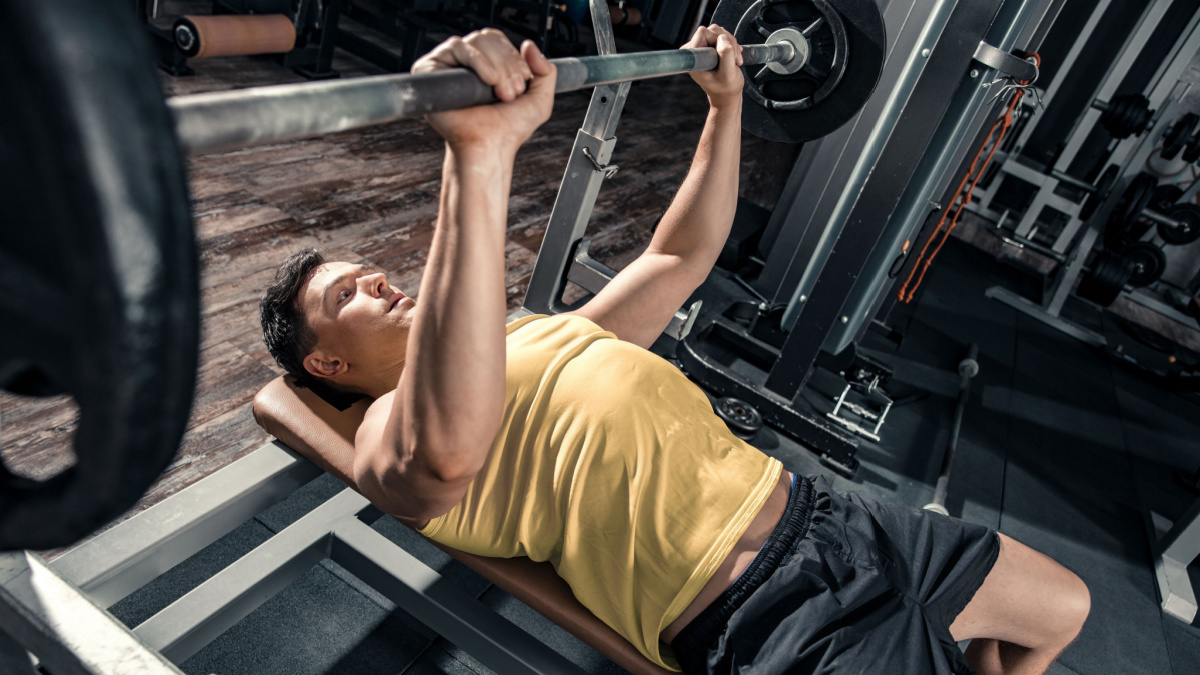
Most lifters in the gym have performed the classic flat bench press to build chest size and upper body pressing strength. When it comes to variations of this time-honored exercise, most lifters adjust the angle to target the “upper chest” using an incline press or focus on the “lower pecs” with a decline bench.
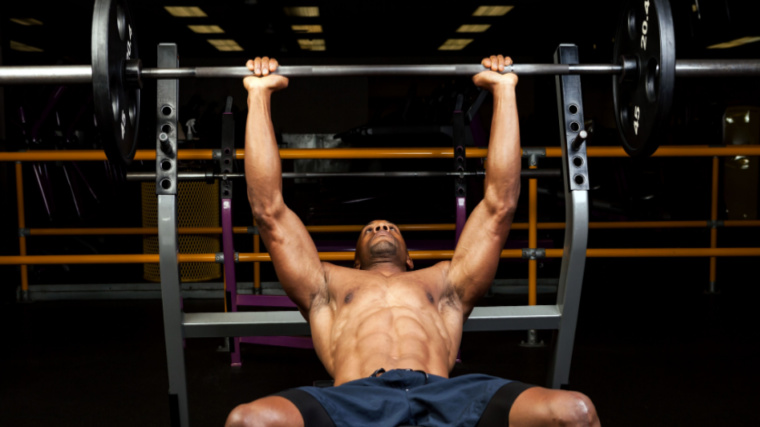
However, many people overlook a highly effective adjustment right at their fingertips, literally. By moving your hand position slightly inward, you turn the chest-building flat bench press into the triceps-building close-grip bench press.
This changes the training stimulus and emphasizes the tricep muscles, increases the movement’s range of motion, and still builds serious upper body pressing power. Here’s everything you need to know about getting started with this simple movement for size and strength.
How to Do the Close-Grip Bench Press
The close-grip bench press biases the triceps muscles with specific exercise performance and a longer range of motion. As its name implies, the close-grip bench press requires your hands to be closer than during a standard bench press. This increases the range of motion and puts your elbows through more elbow flexion and extension, which emphasizes your triceps over your chest.
Step 1 — Set Up on the Bench
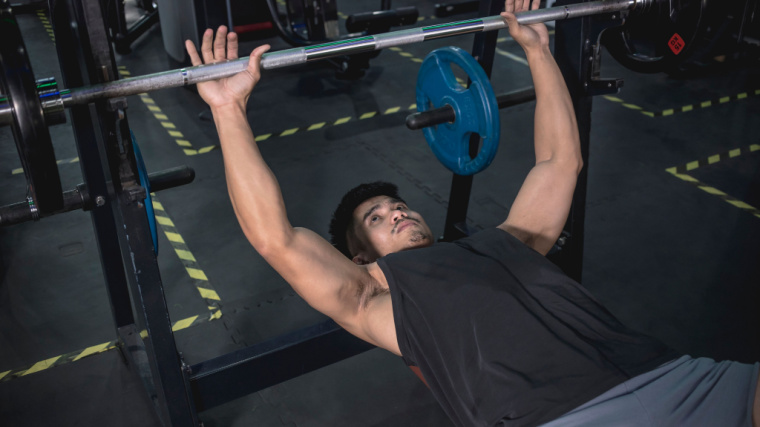
Lie down on a flat bench. Push your feet into the floor to slide yourself up the bench until your eye are under the barbell. Pull your shoulders down and back. Place your hands around the bar in a pronated (palm down) grip with your hands close to shoulder-width apart. (1)
The basic technique should almost identical to your standard flat bench press setup. The primary difference is that your hands should now be at least one fist-width (four to six inches) closer than the chest-focused exercise. This is essential for recruiting more triceps into the movement.
Form Tip: While a relatively close grip is necessary, taking an excessively close grip can be counterproductive, creating more joint strain and less muscular stress. Some old school lifters believe your thumbs should be able to touch during the close-grip bench press. This is inaccurate, impractical, and inefficient advice. Having your hands roughly in line with your shoulders will be effective for the majority of lifters.
Step 2 — Unrack the Bar

Fill your belly and chest with a deep breath and lift the bar from the support pins. Maintain full body tension from your flat feet through your core to your shoulders.
With stiff arms, guide the bar forward until it is over your shoulders. Keep your shoulders pinched back to engage your upper back for support.
Form Tip: The bar should feel balanced when it settles into the ideal position. If you feel like you’re “fighting” an unstable weight above your body, it is either still too far above your face or too far toward your abs. Control the weight and reach a strong, stable position before lowering the weight.
Step 3 — Lower the Bar
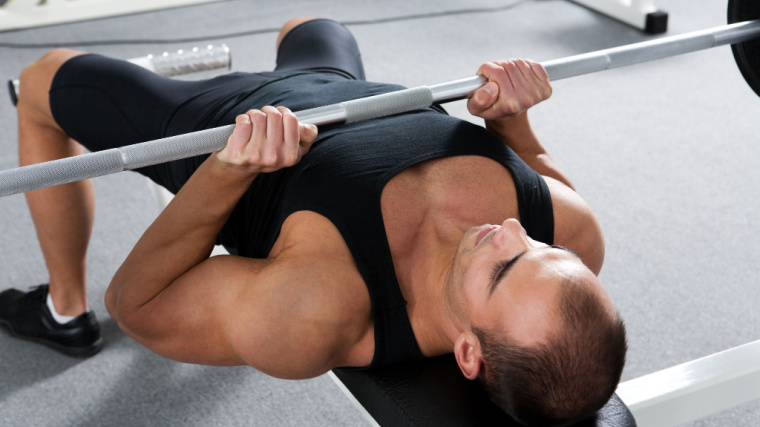
Lower the bar toward your torso, keeping your elbows stacked under your wrists. This position keeps your tricep under tension, avoids compensation from the deltoids (shoulders), and minimizes strain on your joints.
Keep your elbows close to your ribs. If they begin to flare out to the sides, tuck them back in toward your body. Bring the bar down as close to your body as your mobility allows, ideally reaching near your sternum and lower chest.
Form Tip: Don’t allow your wrists to bend back throughout the rep. Keep your knuckles facing the ceiling. This will keep your wrists in a more favorable, less stressful position. It also helps to keep your wrists stacked above your elbows, which is a more powerful pressing position than falling out of line.
Step 4 — Press to the Starting Position
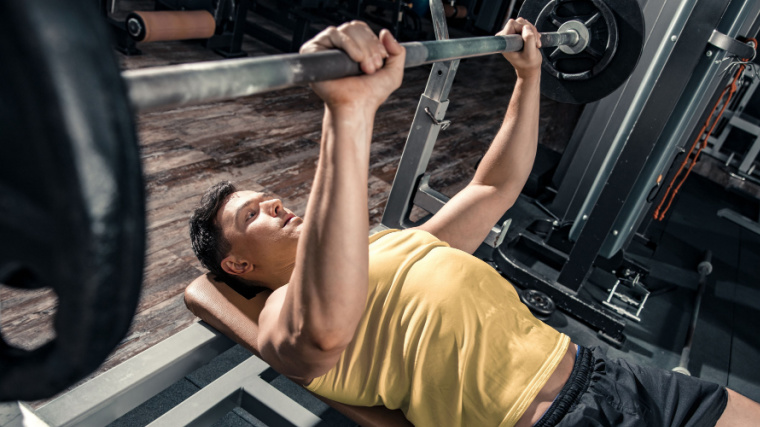
After reaching your maximum comfortable depth, press the bar up to its starting position. Keep your feet flat on the floor and feel total-body engagement. Maintain a neutral wrist position above your elbows.
The bar should end up balanced directly over your shoulders, in the same position it was in after being unracked.
Form Tip: Because the objective of the exercise is to challenge the triceps, actively squeeze your triceps in the locked out position before performing the next repetition.
Close-Grip Bench Press Mistakes to Avoid
There are multiple mistakes that can happen in the close-grip bench press because this free weight exercise has many variables that must be controlled by the lifter.
In contrast, certain machine exercises can lock you into pre-determined positions that do not offer as much positional choice. In other words, manipulating a barbell requires more focus and more muscular control than a similar machine movement. Here’s what to watch out for during this exercise.
Elbows Flaring Out
This is probably the most common mistake people make when doing any triceps exercise. Your elbows must track under your wrists to emphasize the lengthening of the muscle during the eccentric, or lowering phase, of the repetition.
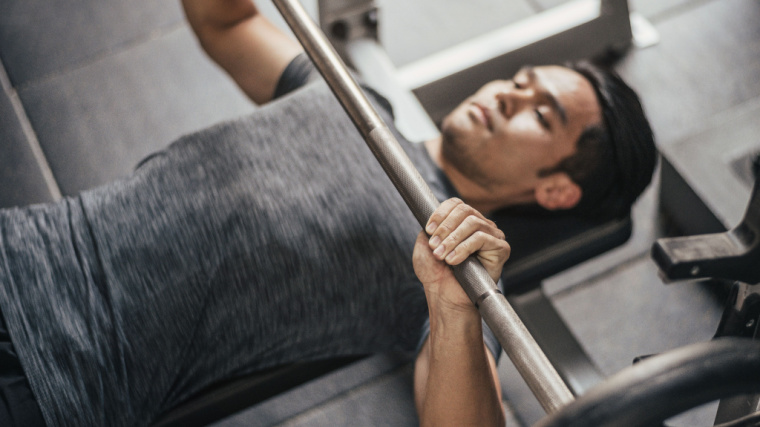
When your elbows flare out to the sides, your shoulders are more strongly contracted, which reduces the load on the triceps.
Avoid it: Use a slow tempo when bringing the bar down toward your chest. Take three seconds to lower the weight and focus controlling your elbow angle. Keep your elbows forward toward your feet rather than out to the side. Once you’ve practiced and feel comfortable, gradually increase the bar speed to a point in which you are able to control your elbow position throughout the entire movement.
Gripping Too Narrow or Too Wide
If your grip is too narrow, your elbows will likely flare out excessively, forcing your deltoids to contribute more to the movement. A too-narrow grip position can also contribute to internal rotation of the shoulder which, over time, may increase the risk of injury to the supraspinatus muscle of the shoulder joint.
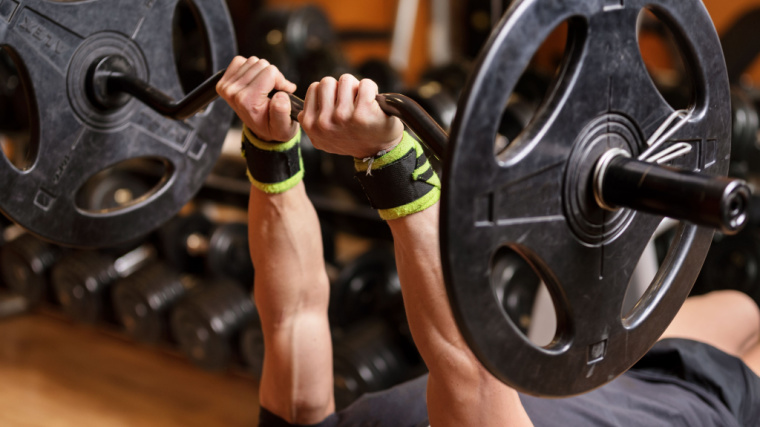
However, a grip that’s too wide can be just as counterproductive, by decreasing the demand on the triceps and increasing chest recruitment. A close-grip bench press without a close grip is a plain old bench press.
Avoid it: Research has shown that the optimal grip for a close-grip bench press is the the same as the distance between the acromion (outer edge) of your shoulder blades.(2) During the setup phase of the exercise, place your hands shoulder-distance apart with your wrists, elbows, and shoulders in a straight line. This will create a customized grip as everyone has a unique shoulder width, rather than telling every lifter in every gym to arbitrarily set their hands 18 inches apart, for example.
Inefficient Bar Path
It is important to remember that the bar path in the bench press is not a strictly vertical line. The bar begins over your shoulders and will travel down and slightly forward as it’s lowered, in a slight arc-like path.
Compared to the standard bench press, the close-grip bench press has an increased range of motion and will therefore have a different touch-point on the body and a different bar path than the standard bench press.
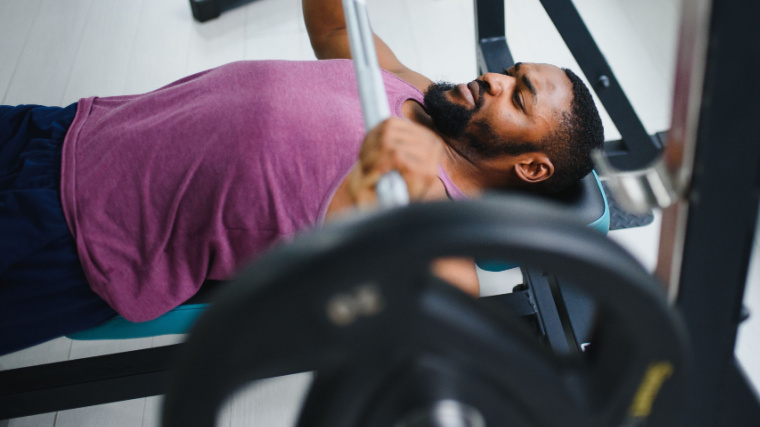
It is important to remember that the bar will touch lower on your chest in a close-grip bench than a standard bench press. If you attempt to use the same touch-point for both movements, it will lead to excessive elbow flare to compensate for the inefficient motion.
Avoid it: Aim for the bar to touch around the narrowing point of the bottom of your sternum — the xiphoid process. However, the exact spot will vary slightly from person to person based on their arm length, ribcage size, and overall body position.
How to Progress the Close-Grip Bench Press
As a basic barbell exercise, the close-grip bench press can be adapted to suit a wide range of lifters’ capabilities with progressively heavier weights. However, if individuals cannot yet manage a full range of motion with the barbell, there are a few options to help achieve the exercise.
Close-Grip Floor Press
The floor press variation reinforces the same close-grip setup and general bar path with a reduced range of motion. While one benefit of the close-grip bench press (performed on a flat bench) is a relatively long range of motion, this floor press variation eliminates the lower portion of the exercise. This reduces shoulder strain while maintaining muscular stress on the triceps.
The close-grip floor press allows you to become familiar with the grip width and hand position, and encourages proper form while staying tight and controlling the movement. Don’t allow your elbows to rest on the ground.
Paused Close-Grip Bench Press
By incorporating a deliberate, long pause at the bottom and top of each repetition, you reinforce proper mechanics throughout the movement. Pause in the bottom, stretched position of every rep for two seconds. It’s crucial that you maintain tension and do not relax with the bar resting on your chest. Your muscles should be tight and engaged for the duration.
Press normally and hold the locked out position for two seconds. Again, don’t treat the pause as an opportunity for rest. Grip the bar hard, flex your triceps, and engage your core before lowering the weight again.
Benefits of the Close-Grip Bench Press
The close-grip bench press has multiple benefits, from performance to aesthetics and even longevity in barbell training. Here’s why you should incorporate this useful movement.
Strength and Performance
For powerlifters or gym-goers looking to increase their max bench press, the close-grip bench press has specific benefits with direct carryover to your bench. If you struggle specifically at lockout, you likely need to improve your triceps strength.
The close-grip bench press primarily challenges the triceps, leading to greater pressing strength.(3) This simple exercise variation could be what is missing from your training routine to push through your sticking point and reach a new bench press PR.
Muscle-Building and Aesthetics
Filling out the sleeves of a shirt is never a bad idea. While triceps dips and pushdowns challenge the lateral head of the triceps in particular, the close-grip bench press significantly recruits the medial and lateral head, leading to more well-rounded muscular development.
This compound (multi-joint) movement also has an increased effect on muscle hypertrophy because it allows you to use relatively heavy weights, which can be useful for stimulating growth.(4)
Joint Health
If you consistently train using a limited range of motion for any muscle or exercise, you can develop strength in that range. However, this can also create a greater risk for strains and tears when those muscles are put through a greater range of motion with “fully lengthened” or “fully shortened” positions. (5)
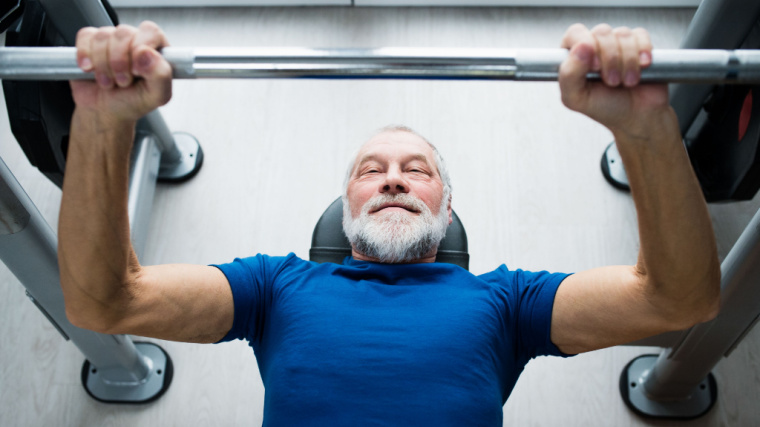
The close-grip bench press does challenge a greater range of motion than the standard grip due to the positioning of the hands on the bar. The shoulder joints are worked through a longer distance. This will stress the triceps in the lengthened ranges, making them more robust and relatively less prone to injury.
Muscles Worked by the Close-Grip Bench Press
The close-grip bench press is most commonly known for challenging the triceps muscles, however there are more muscles involved than you may think.
Pectorals Major and Minor
The pectoralis major and pectoralis minor are your chest muscles and, while they are not the major contributors to the close-grip bench press, they do play an important role in the movement. During both the concentric (lifting) and eccentric (lowering) phases, both the pec major and minor are recruited to lift the weight and push your arms upward.
Anterior Deltoid
Your shoulder is comprised of three separate heads — the front (anterior), side (lateral), and rear (posterior). Each helps to raise the arm in its respective direction from your body’s midline. The anterior deltoid, specifically, contributes to raising and lowering your upper arm during the close-grip bench press.
However, be aware that if your anterior deltoid is fatiguing before other muscles groups during the exercise, your elbows are likely flaring too much. Adjusting your grip and/or bar path should ensure maximum focus on your triceps.
Triceps Brachii
Your triceps make up the majority of your upper arm, relative to your biceps. The triceps muscle consists of three heads — the lateral, medial, and long head — and together their main action is to extend the arm from a bent elbow position to full to elbow extension. The triceps contraction is emphasized in the lockout of the exercise where the triceps are more strongly recruited.
How to Program the Close-Grip Bench Press
When programming the close-grip bench press, the main consideration needs to be your goal. The most effective approach will be determined by what you want to achieve with the movement and how it fits into your overall training plan.
Strength
To prioritize Close-Grip Bench Press Variations
Beyond the close-grip bench press itself, there are some variations you can implement for comparable benefits of hypertrophy and improving your pressing power.
Banded Close-Grip Bench Press
To increase pressing power and/or improve your lockout ability, adding resistance bands of various tension to the close-grip bench press will challenge upper range of motion. Resistance bands offer accommodating resistance — they get more challenging as they’re stretched farther and offer relatively less resistance before they’re maximally stretched.
The biomechanics of the bench press, the lockout position requires less energy and benefits from a leverage advantage. As your elbows become more extended, the weight feels “lighter.” Bands require you to apply maximum tension as resistance increases toward the top position, forcing a stronger contraction. As the bar travels upward, band tension increases at the lockout. This forces you to consciously produce more power and drive hard to achieve lockout.
Machine Press
This is an excellent variation for hypertrophy goals. Using any machine that mimics a similar set up as the close-grip bench gives you more options for hypertrophy. The design of machines allows lifters to efficiently incorporate a variety of high-intensity techniques for increased training stimulus.
Options such as such as drop sets, partial reps, or even Frequently Asked Questions
Why does the close-grip bench press hurt my shoulder?
There could be multiple factors at work, but most people’s shoulders hurt due to a lack of stability in the upper back. This requires a better focus on scapular retraction and depression — pulling your shoulder blades together and down.
During the exercise, make sure to squeeze your shoulder blades back toward your spine and “tuck” them down toward your back pockets. This stabilizes your entire shoulder girdle to support the load. If it’s done incorrectly, or not at all, your anterior deltoid is more strongly activated as your shoulder goes into protraction (reaching forward) and elevation (shrugging up to your ears).
What alternative can I do if I don’t have a bench?
Any exercise that challenges your upper body pressing muscles in a supine position can be an effective alternative. If you don’t have a bench but can lie on the floor, this is a great alternative. A dumbbell or barbell floor press is a great exercise whenever a bench is unavailable. The focus on the upper half of the range of motion further emphasizes triceps recruitment.
Most commercial gyms have steps, boxes, and risers that can be used as modified bench. Ideally, you want the improvised bench to be the same height as a standard one. Place a yoga mat on top of the step or box to reduce the risk of your torso slipping off.
Get a Grip on Your Bench
The close-grip bench press can be performed either as an assistance exercise to boost your classic bench press or it can be approached as a main movement on its own to develop a stronger upper body. The added arm size is an incidental bonus. Apply this simple grip adjustment to a time-tested movement and you’ll soon welcome new levels of size and strength.
References
- Lockie, Robert & Moreno, Matthew. (2017). The Close-Grip Bench Press. Strength and Conditioning Journal. 39. 1. 10.1519/SSC.0000000000000307.
-
Larsen, S., Gomo, O., & van den Tillaar, R. (2021). A Biomechanical Analysis of Wide, Medium, and Narrow Grip Width Effects on Kinematics, Horizontal Kinetics, and Muscle Activity on the Sticking Region in Recreationally Trained Males During 1-RM Bench Pressing. Frontiers in sports and active living, 2, 637066. https://doi.org/10.3389/fspor.2020.637066
-
Saeterbakken, A. H., Stien, N., Pedersen, H., Solstad, T., Cumming, K. T., & Andersen, V. (2021). The Effect of Grip Width on Muscle Strength and Electromyographic Activity in Bench Press among Novice- and Resistance-Trained Men. International journal of environmental research and public health, 18(12), 6444. https://doi.org/10.3390/ijerph18126444
- Brandão, Lucas & Painelli, Vitor & Lasevicius, Thiago & Silva-Batista, Carla & Brendon, Helderson & Schoenfeld, Brad & Aihara, Andre & Cardoso, Fabiano & Peres, Bergson & Teixeira, Emerson. (2020). Varying the Order of Combinations of Single- and Multi-Joint Exercises Differentially Affects Resistance Training Adaptations. Journal of Strength and Conditioning Research. 34. 1. 10.1519/JSC.0000000000003550.
-
Valamatos, M. J., Tavares, F., Santos, R. M., Veloso, A. P., & Mil-Homens, P. (2018). Influence of full range of motion vs. equalized partial range of motion training on muscle architecture and mechanical properties. European journal of applied physiology, 118(9), 1969–1983. https://doi.org/10.1007/s00421-018-3932-x
-
Mangine, G. T., Hoffman, J. R., Gonzalez, A. M., Townsend, J. R., Wells, A. J., Jajtner, A. R., Beyer, K. S., Boone, C. H., Miramonti, A. A., Wang, R., LaMonica, M. B., Fukuda, D. H., Ratamess, N. A., & Stout, J. R. (2015). The effect of training volume and intensity on improvements in muscular strength and size in resistance-trained men. Physiological reports, 3(8), e12472. https://doi.org/10.14814/phy2.12472
Featured Image: Daniel Krason / Shutterstock


